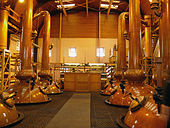Clynelish distillery
This article has multiple issues. Please help improve it or discuss these issues on the talk page. (Learn how and when to remove these messages)
|
| Region: Highland | |
|---|---|
| Location | Brora, Sutherland |
| Owner | Diageo |
| Founded | 1819 |
| Status | Operational |
| Water source | Clynelish burn |
| No. of stills | Three wash, three spirit |
| Capacity | 4,800,000 litres |
| Clynelish 14 year old | |
| Type | Single malt |
| Age(s) | 14 Years |
| Cask type(s) | Sherry and Bourbon |
| ABV | 46% |
| Clynelish 20 year old Bi-Centenary bottling. (200 year anniversary) | |
| Type | Single malt |
| Age(s) | 20 years |
| Cask type(s) | Sherry |
| ABV | 57.3% |
| Clynelish Distillery Only Bottling | |
| Type | Single malt |
| Age(s) | Non aged statement |
| Cask type(s) | Bourbon ABV 3 = 48% |
Clynelish Distillery is a distillery near Brora, Sutherland in the Highlands of Scotland.

The original Clynelish distillery was built in 1819, adjacent to the present operational Clynelish distillery which was built in 1967. When Clynelish first started distilling, in the years 1820-1822 they were producing around 12,000 gallons (around 54,000 litres) Over the years the distillery passed from owner to owner until the distillery expanded around 1896 and was upped to around 580,000 litres.[1] This was when they added in extra warehouses on site.
However, in the 1960s, more and more of Clynelish's spirit was going into the blends, and in the 1960s there was a boom and people were buying more luxury items such as cars and whisky. So they needed to up their production levels. So in 1967 they built the current distillery they produce in today. The two distilleries ran side-by-side as Clynelish A and Clynelish B for a while as they wanted to make sure they had perfected the taste in the new space, then closed the older distillery the following year.[2]
However, in the following years, Caol Ila distillery faced a drought and closed for a year and did refurbishments. Johnnie Walker was missing this peated whisky in their blends and needed something to go in its place. So Clynelish reopened the original distillery in May 1969, under the name Brora Distillery, and started making Brora whisky. Brora's PPM levels (Phenol Parts per Million) – which is what is used to talk about the level of peat used in the whisky - started at around 30-35 PPM, which is on level with Caol Ila (30-35 PPM) and Lagavulin (35-40 PPM).[3]
Brora went into the blends for one year whilst Caol Ila was closed and then continued to make the whisky as a single malt and ran until July 1983. Following closure in 1983, Brora whisky has become one of the most rare and desired whiskies in the world, costing around one and a half thousand pounds a bottle. Brora's latest, and last release of the original spirit is in their bi-centenary bottling, to celebrate the 200 years of the distillery being in production. This bottling is a 40 year old Brora selected to celebrate this, making 1819 bottles to represent the first year the distillery first started producing.
Clynelish has had a strong connection with Johnnie Walker blended whisky for many years. Around 95% of the spirit is used in Johnnie Walker, Most commonly found in the Gold Label Reserve.
References
- ^ Dr Patrick Brossard : BRORA ; A Legendary Distillery (1819-1983) and Whisky
- ^ https://www.malts.com/en-row/distilleries/clynelish/
- ^ Dr Patrick Brossard : BRORA ; A Legendary Distillery (1819-1983) and Whisky
- Jackson, Michael, (2004). The Malt Whisky Companion, Penguin Books 2004 ISBN 9781405302340
- http://www.maltmadness.com/whisky/clynelish.html
- Dr Patrick Brossard : BRORA ; A Legendary Distillery (1819-1983) and Whisky

